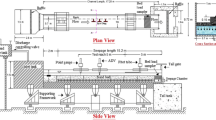Abstract
Widely applied in maintaining estuarial waterway depth, the spur dike has played an important role in currents and sediment exchange between channel and shoal and sediment back-silting in the channel. Through establishing a generalized physical model at a bifurcated estuary and conducting current tests under the joint action of runoff and tide, the influence of the spur dike length on current exchange between channel and shoal is analyzed. Results show that when the spur dike length reaches a certain value, the direction of the flow velocity shear front between the channel and shoal will change. The longer the spur dike, the larger the transverse fluctuating velocity at the peak of flood in the channel shoal exchange area, while the transport of the transverse hydrodynamics is obvious in the process of flood. There is an optimum length of spur dike when the shear stress in the channel and the longitudinal velocity in flood and ebb reach the maximum, and the flow velocity will decrease when the spur dike length is smaller or larger than the optimum. For a certain length of spur dike, the larger the channel shoal elevation difference, the larger the peak longitudinal flow velocity in the middle of the navigation channel in flood and ebb. However, the transverse flow velocity will first decrease and then increase. The transverse transportation is obvious when the channel shoal elevation difference increases.
Similar content being viewed by others
References
Dou, X.P., Gao, X.Y., Pan, Y. and Ding, L., 2015. Analysis of siltation in Yangtze deepwater channel, Proceedings of the 17th Chinese Symposium on Ocean (Shore) Engineering, Nanning, China, 839–843. (in Chinese)
Hill, P.S., Newgard, J.P., Law, B.A. and Milligan, T.G., 2013. Flocculation on a muddy intertidal shoal in Willapa Bay, Washington, Part II: observation of suspended particle size in a secondary channel and adjacent shoal, Continental Shelf Research, 60, S145–S156.
Huijts, K.M.H., de Swart H.E., Schramkowski, G.P. and Schuttelaars, H.M., 2011. Transverse structure of tidal and residual flow and sediment concentration in estuaries, Ocean Dynamics, 61(8), 1067–1091.
Jin, L., Yu, Z.Y. and He, Q., 2013. Study on river regime control and siltation in deepwater channel, China Harbour Engineering, (1), 101–108. (in Chinese)
Kim, S.-C., Frienrichs, C.T., Maa, J.P.-Y. and Wright, L.D., 2000. Estimating bottom stress in tidal boundary layer from a Coustic Doppler velocimeter data, Journal of Hydraulic Engineering, 126, 399–406.
Liu, M., Wu, H.L., Li, W.H., Liu, G.F. and Guo, W.H., 2011. Observational study on flow and sediment transport overtopping the south leading jetty in the Yangtze Estuary Deepwater Channel Regulation Project, The Ocean Engineering, 29(2), 129–134. (in Chinese)
Mariotti, G. and Fagherazzi, S., 2011. Asymmetric fluxes of water and sediments in a mesotidal mudshoal channel, Continental Shelf Research, 31(1), 23–36.
Nowacki, D.J. and Ogston, A.S., 2013. Water and sediment transport of channel-flat systems in a mesotidal: Willapa Bay, Washington, Continental Shelf Research, 60, S111–S124.
Pacheco, A., Williams, J.J., Ferreira, Ó. and Dias, J.A., 2009. Evaluation of shear stress computation at a tidal inlet using different methods, Journal of Coastal Research, SI56, 1385–1389.
Pope, N.D., Widdows, J. and Brinsley, M.D., 2006. Estimation of bed shear stressing using the turbulent kinetic energy approach–A comparison of annular flume and field data, Continental Shelf Research, 26(8), 959–970.
Svendsen, I.A., 1987. Analysis of surf zone turbulence, Journal of Geophysical Research-Oceans, 92(c5), 5115–5124.
Tan, Z.W., Fan, Q.J., Zheng, W.Y. and Zhu, J.F., 2009. Analysis of reasons for the siltation in North Passage of Yangtze Estuary, Port & Waterway Engineering, (6), 91–102. (in Chinese)
Zhu, H.F., 1995. Effect of suspended sediment dynamic in shear fronts of estuary, Resources and Environment in the Yangtze Valley, 4(1), 54–57. (in Chinese)
Author information
Authors and Affiliations
Corresponding author
Additional information
Foundation item: The research was financially supported by the National Natural Science Foundation of China (Grant No. 51479122) and the National Key Research and Development Program of China (Grant No. 2017YFC0405400).
Rights and permissions
About this article
Cite this article
Jiao, Zx., Dou, Xp., Zheng, Jh. et al. Influence of spur dike on hydrodynamic exchange between channel and shoal of generalization estuary in physical model test. China Ocean Eng 31, 624–630 (2017). https://doi.org/10.1007/s13344-017-0072-8
Received:
Revised:
Accepted:
Published:
Issue Date:
DOI: https://doi.org/10.1007/s13344-017-0072-8



